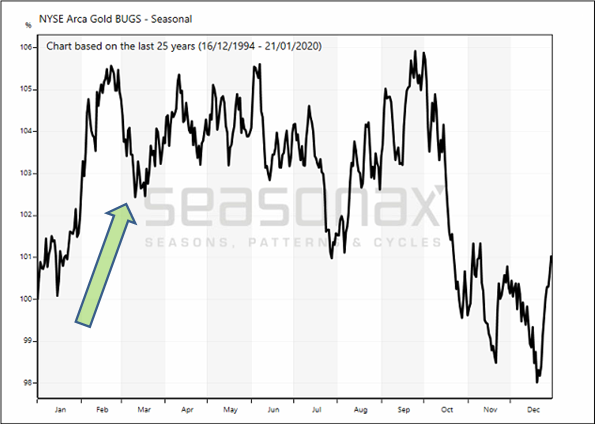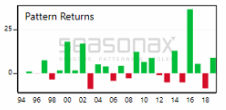Dear Investor,
Mining stocks track precious metals seasonality
Take a look at the seasonal chart of the HUI gold mining index below. This is not a standard chart depicting price moves over a specific time period. Rather, the seasonal chart shows the moves in the HUI in the course of a calendar year averaged over the past 25 years.
HUI seasonal pattern over the past 25 years

The HUI index typically rallies in February
As the chart illustrates, gold & silver mining stocks typically begin to rally in December. In January they continue to move higher in a choppy and somewhat muted advance. Then prices rise steeply until the end of February. Thereafter the seasonal average declines again.
In short, the strongest seasonal advance in precious metals mining stocks lies directly ahead.
Seasonal strength is driven by fundamentals!
Thus gold and silver mining stocks track the seasonal patterns of precious metals.
The seasonal advance in precious metals is probably driven by purchases of industrial users (fabrication demand). Many industrial processors place large purchase orders at the beginning of the financial year, once annual planning has been completed and new orders can be booked.
By extension the seasonal rally in precious metals mining stocks is therefore underpinned by fundamentals as well.
An annualized gain of almost 100 Percent!
The strongest part of the seasonal rally takes place between 28 January and 18 February.
The average return achieved in this time period stood at 4.03 percent. This is equivalent to 98.75 percent annualized! It is therefore an extraordinarily strong seasonal advance.
The following bar chart shows the price moves between 28 January and 18 February in every single year since 1994. Green bars indicate years in which gains were posted, red bars indicate losses.
HUI, return in percent, between 28 Jan and 18 Feb in every single year since 1994

Prices frequently rise very strongly.
As the chart demonstrates, the distribution of returns is not particularly uniform. The reasons: the gold mining sector is highly speculative, and what’s more, it has been frequently mired in bear markets in the past 25 years, which have a negative effect in all time periods of the year.
However, as a result gains in these 15 trading days can be all the more spectacular. For example, in 2016 the HUI index rallied by 36.65%!
Take advantage of single stock seasonality!
As you can see, individual shares or sectors often exhibit unique seasonal patterns due to various fundamental reasons.


